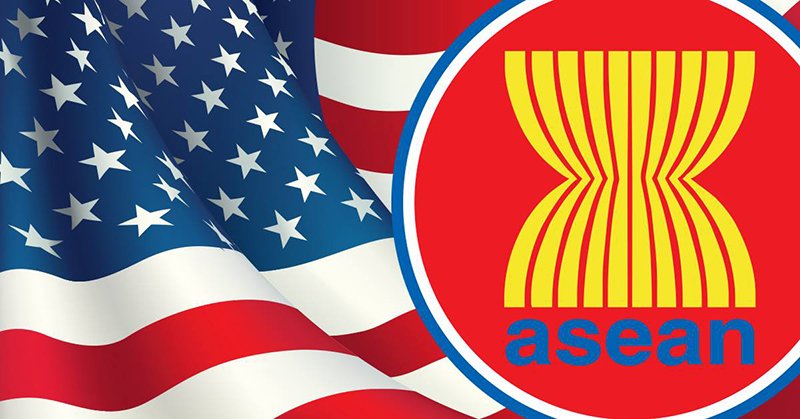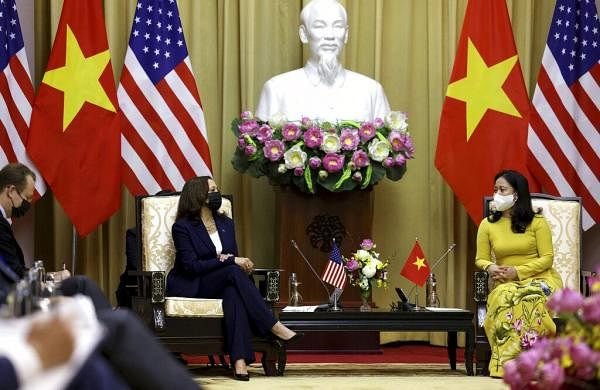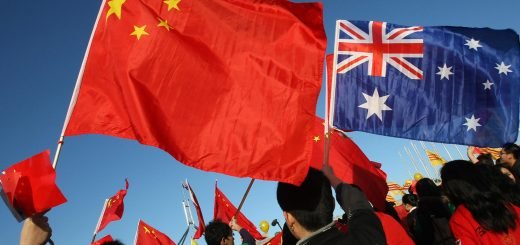Voyage in troubled waters – American ambitions in Southeast Asia

It was on April 29, 1975, at 22 Gia Long Street in Saigon (now Ho Chi Minh City) that one of the most defining pictures of the American retreat from Vietnam was caught. The photo clicked by Dutch photojournalist Hugh Van Es captured an American helicopter loading Vietnamese people including the then South Vietnam Prime Minister and his family and flying them to safety. Fall of Saigon is now compared by many, with the fall of Kabul. Maybe, the challenge is bigger, more complex?
Kabul – A retreat after two decades
While Saigon involved pulling out 7000 Americans along with tens of thousands of Vietnamese helpers, Kabul involved pulling out 5500 Americans and approximately 1,20,000 Afghan interpreters, translators and helpers, and citizens and helpers of ally nations. The scramble for a passage to safety was brutally exploited by ISIS Khorasan as well which sent fidayeen to take the lives of more than 160 people including 13 US soldiers posted at the airport boundary as well. The US still stuck to its deadline of 31 August and finally pulled out of Afghanistan after two decades of excruciatingly long stay leaving behind Afghanistan as it was twice decades ago – under the Taliban’s repressive theocracy. Just when Joe Biden was facing tough questions from the Press for his stubbornness in pulling out troops from Afghanistan, Kamala Harris embarked on a visit to Vietnam and Singapore or as largely reported – Southeast Asia.
America’s renewed Indo Pacific push
Southeast Asia and largely the Asia Pacific has been in the focus of the US ever since the peaceful rise of China turned into a strategically adverse rise of China for the US. Obama administration’s ‘Pivot to Asia’ and active engagement with TPP was a manifestation of the importance that the US attests to the region. As Donald Trump took China by its horns, the region saw an increased maritime presence of the American Navy in Indo Pacific waters including the South China Sea and the Taiwan Strait in particular. American military sales to Taiwan reached $5.1 billion in 2020. Trump and Biden alike, have sent multiple diplomats to Taiwan. American FONOPs in 2020 challenged 10 excessive maritime claims in South and East China and the corresponding number for the overall Indo Pacific was 15. The US has Thailand and the Philippines as treaty allies in the region. The US also enjoys a comprehensive partnership with Vietnam and a strategic partnership with Singapore. Former US Secretary of State Hillary Clinton had opined that American engagement in the Asia Pacific region will ensure American leadership in the 21st century just like post world war transatlantic engagement kept it supreme in the 20th century. While a NATO-like alliance in the region is a far fetched idea because of the intense economic dependence of regional countries on China and the previous failure of SEATO to sustain itself, the US aims to get a warm environment for its naval movements in the rough waters of Indochina by all the countries beleaguered by aggressive Chinese actions in the seas. Fatigued by wars in the middle east which are no longer fruitful, the US aims to shift its focus from the middle east to Indo Pacific, the fastest-growing region with half of the world’s population. ASEAN stands second in US exports to Indo Pacific and the fourth largest export market overall, and America just doesn’t want to let it go.

Belligerent China – Happy China
The withdrawal of American forces from Afghanistan has given a field day to Chinese media houses, especially state-run media groups who mocked the ill-planned and incautious American retreat. Not only did they satirically present Biden’s slogan of ‘America is back as a hasty and coward retreat of American forces back to the US, but they also offered partly veiled and partly unveiled threats to regional countries of Asia Pacific and Taiwan in particular. State-run Global Times highlighted America’s habit of abandoning allies owing to its self-interests, be it France after its independence in 1776 or Vietnam in 1975. It further mocked Taiwan’s President for expressing condolences on the demise of President Biden’s dog but not commenting on the American loss in Afghanistan and ended with the advice to the ruling DPP to fall in line instead of being ‘strategic pawns of the US as the US won’t come to its aid when CPC would mount an attack on the island nation it sees as its own.
American commitments – guided by suitability or sustainability?
Kamala Harris’ visit to Vietnam and Singapore thus, doesn’t come by chance but to assuage the insecurities of the nations in the region concerning American commitment in the region against an increasingly hostile and aggressive China. The last few years in the ASEAN region have been rocky for the Americans. Xi’s China has become arrogant with each passing day and the smaller regional countries who are now intricately dependent on the Chinese economy can simply not find a way around. Donald Trump’s withdrawal from TPP was quickly grabbed by China as an opportunity to finalize RCEP which was finally signed by 15 Indo Pacific countries in 2020 thereby providing more clout to China in the region. The Americans are also struggling to keep their bilateral alliances with Thailand and the Philippines functional. While Thailand’s military government is seen as contrary to the democratic spirit which the US always espoused in the region back in the 1950s and 60s, making Thailand its base, the Philippines is closing on to China due to perceived

economic benefits from China’s maritime silk road project and American hostility to Duterte’s regime as well. While America criticized Duterte’s regime over its violent crackdown on drug dealers, he went closer and closer to China even announcing ‘separation’ from the US. American engagements with Taiwan have increased rapidly in the past few years but the recent actions of the Biden administration in Afghanistan will have a profound negative impact on the perceived sincerity of American commitment to Taiwan’s defence. Taiwan has been at the receiving end of Chinese fighter jets invading Taiwanese airspace every time a major American FONOP or a military exercise is held in Indo Pacific by the US. The world has seen how China effectively nullified democracy in Hong Kong and undertook reprisals against pro-democracy voices there while the west found itself helpless in taking any deterring countermeasure against Beijing, but just pass statements. Taiwan’s worries are well placed since American commitments have also time and again been reversed, recalibrated and restructured depending upon its domestic political environment. One staunch US ally in the region is Singapore with whom the US cooperates on a range of security issues like maritime security, border control, cybercrime and counter-terrorism, and the dispatch of Harris to the safer and predictable allies like
Singapore and Vietnam are seen as a clever tactic of American administrations to reaffirm its engagement with the region sans the Afghan embarrassment.
ASEAN Centrality in peril
The US is playing a leading role in the Quad, a grouping of 4 Indo pacific states namely the US, India, Australia and Japan. The engagement was revived in 2017 with the leaders of the four-nation meeting in Manilla on the sidelines of the 2017 ASEAN Summit and has gained strength with each passing year. The new administration has also decided to intensify American engagement manifested best in the form of the first virtual summit of Quad leaders in March 2021. The US is looking to even widen the scope of Quad with a Quad Plus arrangement which will include New Zealand, Vietnam and South Korea, not ASEAN. China sees Quad as an exclusive clique working against China while the Quad nations have asserted that the grouping is aimed at ensuring a free and open Indo Pacific which is inclusive, healthy, anchored by democratic values and unconstrained by coercion. Amidst all this, it is not just China that is worried, but there is scepticism in ASEAN too. Quad is portrayed by many as a tool to relegate ASEAN to the sidelines by bringing other major powers in the play and thus put the long advocated ASEAN centrality in jeopardy. It fears that the region may yet again become a theatre for war, this time between Quad and its allies and China – Russia combines a possibility that increasingly seems to turn into a reality. Quad has asserted that ASEAN is central in its vision of free and open Indo Pacific but the latest American actions in Afghanistan cast a doubt on all that the US commits. The US has also been continuously urging Mekong and ASEAN nations to take concrete steps against the junta regime in Myanmar which by some experts is seen as an attempt to weaken ASEAN unity and disturb the balance of power by dictating its ideals and values to the ASEAN.

The solution lies in finance, not military
ASEAN is vital to the interests of all, not just China or the US. ASEAN as a block has emerged as a strong force overtime with deep strategic interests and a strong economic profile. More than 60% of maritime trade passes through the South China Sea (SCS), making it central to global trade. It is in the interests of all, including ASEAN to ensure the area remains free, open and inclusive and not become a military backyard of China. But the US needs to understand that China’s engagement with ASEAN is not just limited to offensive boundary claims in SCS, flexing of military muscles or eyes on the resource-rich seabed of SCS. It permeates all levels of ASEAN governance and economy. The shared culture and heritage mean China has the soft power to yield on ASEAN citizenry, and the economic investments in the form of OBOR, credit lines and key infrastructure projects mean China continues to be looked upon as a source of funds for the resource-starved developing countries of the region. China is also the largest trading partner of ASEAN which the regional countries can’t ignore. The American military actions in the region would not result in substantial outcomes unless they are backed by vibrant economic investments. America and its allies need to present an alternative market to ASEAN for its goods and invest in the capacity building of the regional countries. Investment in ASEAN will be a win-win for all, with the world diversifying supply chains and ASEAN getting some space to stand up against aggressive Chinese actions.


















